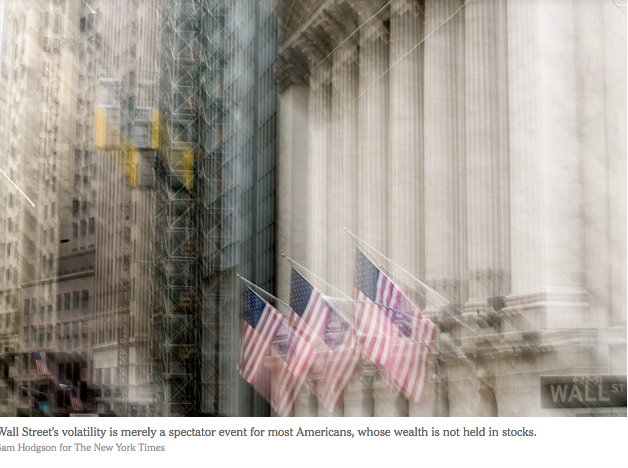Take a deep breath and relax.
The riotous market swings that have whipped up frothy peaks of anxiety over the last week — bringing the major indexes down more than 10 percent from their high — have virtually no impact on the income or wealth of most families. The reason: They own little or no stock.
A whopping 84 percent of all stocks owned by Americans belong to the wealthiest 10 percent of households. And that includes everyone’s stakes in pension plans, 401(k)’s and individual retirement accounts, as well as trust funds, mutual funds and college savings programs like 529 plans.
“For the vast majority of Americans, fluctuations in the stock market have relatively little effect on their wealth, or well-being, for that matter,” said Edward N. Wolff, an economist at New York University who recently published new research on the topic.
Both Republicans and Democrats have promoted the idea that a rising stock market broadly lifts Americans’ fortunes. When there was a parade of market rallies, President Trump asked, “How’s your 401(k) doing?”
There was a move toward democratizing stock ownership in the 1980s and 1990s, with the advent of individual retirement accounts, but the busts of 2001 and 2007 scared off some middle-class investors.
Household Wealth Trends in the United States, 1962 to 2016: Has Middle Class Wealth Recovered?
Edward N. Wolff
NBER Working Paper No. 24085
Issued in November 2017
NBER Program(s):Productivity, Innovation, and Entrepreneurship
Asset prices plunged between 2007 and 2010 but then rebounded from 2010 to 2016. The most telling finding is that median wealth plummeted by 44 percent over years 2007 to 2010. The inequality of net worth, after almost two decades of little movement, went up sharply from 2007 to 2010, and relative indebtedness for the middle class expanded. The sharp fall in median net worth and the rise in overall wealth inequality over these years are largely traceable to the high leverage of middle class families and the high share of homes in their portfolio. Mean and median wealth rebounded from 2010 to 2016, by 17 and 28 percent, respectively. While mean wealth surpassed its previous peak in 2007, median wealth was still down by 34 percent. More than 100 percent of the recovery in both was due to a high return on wealth but this factor was offset by negative savings. Relative indebtedness continued to fall for the middle class from 2010 to 2016, and wealth inequality increased somewhat. The racial and ethnic disparity in wealth holdings widened considerably between 2007 and 2016, and the wealth of households under age 45 declined in relative terms.




